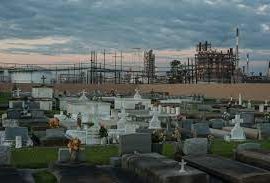
The National Urban Leagues has asked the EPA to look at the grain company for civil rights violations.
The National Urban League and its president and chief executive, former New Orleans Mayor Marc Morial, have upped their opposition to the proposed $400 million Greenfield Louisiana grain elevator terminal in Wallace by asking the Environmental Protection Agency to conduct a civil rights investigation into the terminal’s backers. “We believe that an investigation is consistent with your recent announcements of a new Office of Civil Rights at the Environmental Protection Agency which has jurisdiction with respect to this,” Morial wrote in an Oct. 19 letter to EPA Administrator Michael Regan. “EPA is in receipt of the correspondence and is in the process of reviewing it,” said Taylor Gillespie, an EPA spokeswoman. Officials with Greenfield insist that the facility will not pose an environmental or civil rights problem for the community. “We are committed to partnering with the community as we work to fulfill a core part of our mission — combating the legacy of environmental injustice that has historically damaged the health and well-being of Black communities along the Mississippi,” said Kyle Egbert, interim chief executive and chief finance officer for Greenfield Holdings, LLC. “As we have said in the past, we look forward to meeting with any concerned community member to transparently address any misconceptions.”
nola.com
The terminal is taller than the Statue of Liberty and will encircle the Whitney Museum.
In his letter to Regan, Morial pointed out that the terminal would stand 283 feet high, higher than the Statue of Liberty, on the 238-acre terminal site that would encircle both the Whitney Plantation Museum and the Wallace community. “It is our view that this terminal and the potential damage to both the air, water, and quality of life in those areas of St. John the Baptist Parish, which is a historic African American community, violates the civil rights and environmental laws of the nation,” Morial wrote. Morial had written a June 3 letter directly to officials at Engine No. 1, the San Francisco-based group funding the terminal, in which he also said the project would harm the museum, which features the history of enslaved Africans who worked the sugarcane and indigo fields that were the base of Louisiana’s economy before the Civil War. Morial’s third-great grandfather, Victor Haydel, was born a slave in 1835 on Habitation Haydel, the site now known as the Whitney Plantation. The plantation dates back to 1803, and the plantation historical district was added to the National Register of Historical Places in 1992. The Descendants Project, a Wallace-based community organization that has opposed the project since it was announced nearly two years ago, issued a statement supporting the Urban League’s request. “The desecration of sacred land, Wallace’s rich history, and our vibrant Black descendant community with the proposed development of Greenfield’s grain elevator is a civil rights violation. We are Wallace’s past and present, and we are fighting every day to ensure its future. We need the EPA to join us in this fight for justice and preservation,” said the statement.
The Urban Leagues and others have oppose the terminal for environmental reasons also.
Both the Urban League and the Descendants group, and several other environmental and local community organizations, also cite the proposed facility’s environmental impacts, including small-sized particulate matter from grain storage and loading operations, in their opposition to the facility. Air quality permits already issued by the Louisiana Department of Environmental Quality would allow Greenfield to emit 37 tons of fine particulate matter a year. That size of particulates, easily inhaled deep into the lungs, where it can then enter the bloodstream, has been linked to respiratory problems, including decreased lung function, by the EPA. In August, DEQ turned down a request by the Tulane Environmental Law Clinic, on behalf of Wallace community groups, to reopen its permitting process to allow for additional public hearings, concluding that Greenfield’s driving of piles to be used for advanced testing and eventual foundations for environmental control equipment met the state’s definition for the start of construction.
Another matter are the slaves graves which are unmarked.
One concern raised by community groups is whether graves of slaves remain on the property purchased by Greenfield for the terminal. A spokesman for the Army Corps of Engineers said it is early in the process of considering permits for the project, in part because it is conducting a review of whether the project will violate the National Historic Preservation Act. The facility would be located in an area that already is the site of a number of petrochemical plants with high emissions of particulate matter and of toxic chemicals. And two weeks ago, EPA sent a “notice of concern” to the state Departments of Environmental Quality and Health, notifying them that state officials may be violating federal civil rights laws and regulations by allowing Black people to suffer disproportionate impacts from air pollution in Louisiana’s industrial corridor, including an increased risk of cancer. Greenfield’s Egbert denied the facility would pose an environmental threat to the community. The company says the loading terminal and 54 silos will provide more than 100 full-time jobs that will be available for local residents. “We agree with Mr. Morial that civil rights and environmental justice considerations are central to responsible economic development, and we are confident that our model of community engagement, in concert with statutory and regulatory reviews that are currently underway, such as a robust environmental justice analysis and the US Army Corps’ Section 106 and environmental permitting review, will produce an outcome that ensures the protection of air quality, water quality, and quality of life in St. John the Baptist Parish as it relates to the project,” he said. “In reality, Greenfield will be the cleanest grain export facility in North America and is designed to outperform all environmental standards,” he said. “The Grain Export Facility will be a low-emission site used for grain storage and river transport, with no on-site production, refining or manufacturing.”
Greenfield is showing community spirit by helping with the Kid Ory house.
Greenfield also recently provided a grant that allowed the reopening of the 1811 Kid Ory Historic House in nearby LaPlace, part of the Andry or Woodland plantation, which dates to the 1790s and is known both as the starting place of the 1811 German Coast slave uprising and the birthplace of jazz trombonist Edward “Kid” Ory. The one-time grant is being used to pay rent on the Ory house through April. The museum had closed on Oct. 1 after less than two years of operation because of financial pressures in the wake of Hurricane Ida. The Greenfield grant was just part of funding provided to a new, nonprofit limited liability corporation that will run the home.
Greenfield is trying the history of grain terminals is against them.



